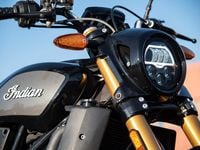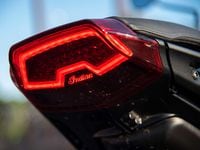Not gonna lie. After I couldn't make the media launch of the Indian FTR 1200 S in Baja California, reading Adam Waheed's review made me seriously bummed I missed the first ride. The Mexican combo of sand and tarmac seemed like an outstanding test for a bike positioned a flat-track racer for the road; the missed opportunity hit me with a fierce case of FOMO.
By the time an Indian FTR 1200 S finally made its way to my driveway, I decided to put it through its paces in a different way: by tackling LA traffic, which happens to be in the only state in the union where lane-splitting is not explicitly illegal.
Indian’s latest ride comes in two trim levels. The standard FTR 1200, which starts at $13,499, is available in any color as long as it’s Thunder Black. The $15,499 FTR 1200 S adds a touchscreen color display, three ride modes, fully adjustable suspension, and lean-sensitive traction and stability control—oh, and the choice of three colors including “Race Replica,” which elevates the grand total to $16,999.
For those of you acquainted with the de facto domestic bike builder from Milwaukee, Indian does things a bit differently. For starters, the S model's instrumentation goes fully digital, dropping a 4.3-inch color touchscreen in place of conventional analog gauges. The LCD glows establishes an unexpectedly modern mood, one that adds a dash of contemporary complement to the V-twin's old-school thrum. Climb aboard, and the 33.1-inch seat height might demand more of a stretch than expected; after all, the FTR has a considerably more elevated stance than Indian's familiar Scout, whose 25.8-inch perch allows you to simply plop right down for a ride. There's a bit of a reach to the ProTaper handlebars, and the leg position puts your boots in a snug, swept-back position, a sentiment echoed by Julia LaPalme in her writeup on the bike. This makes for a sportier-than-expected ergonomics, making this closer to Harley-Davidson's late, great XR1200 than a conventional, laid-back cruiser.
It takes a moment to familiarize with the FTR’s interface, whose menu function are maneuvered via three hard buttons along side the 4.3-inch touchscreen and a button/joystick combo on the left switch gear. The screen is clear and bright, and the virtual buttons easy enough to press while on the go. Select Rain, Standard, or Sport riding modes, and the engine power and throttle response responds accordingly. Once you’ve acquainted yourself with switch gear and touchscreen, it becomes easy to swap layouts and hook up to your phone’s Bluetooth, which enables dialing and music-streaming interfaces to be managed via the bike.
The liquid-cooled 1,203cc V-twin fires up with a mellow beat, and responds crisply to throttle twists. Click the shifter into first gear, and you’ll need to carefully and slowly release the clutch lever to find the friction point, which constitutes a minuscule section of the lever movement. Release the clutch rapidly while squirting the gas, and the V-twin’s 87 pound-feet of torque will lurch you forward like a newbie who hasn’t quite mastered the whole shifting thing. But once you’ve gotten used to the narrow engagement point and throttle responsiveness, it just takes a bit of attention and care to engage gearshifts smoothly.
My first few miles aboard the FTR felt engaging and enjoyable, with enough clearance to encourage reasonably spirited cornering. Indian claims 43 degrees of lean angle in either direction before touchdown, and we believe it. The 120/70-19 front and 150/70-18 rear Dunlops are clearly sized for maneuverability and handling responsiveness, not visual road presence or thick-tire posturing. We respect that honesty of function, and find that the skinny tire setup makes the 518-pound bike feel lighter on its feet than the spec sheet might suggest. Hard-core handling fanatics might crave a bit more range of body control and bump compliance via a more sophisticated rear suspension setup, something Waheed also pointed out in his review.
As the miles wore on, a few other things became apparent. For starters, the seat’s thinness transfers engine vibes rather directly to the rider’s bottom, a sensation that is fine and dandy during around-town riding, but can become annoying on longer haul rides—as it did during my two-hour round-trip ride from LA to Newport Beach. Another area of note is the engine’s thermal generation, which created a noticeable amount of heat in the thigh area when ambient temperatures were in the 80-degree range. The sensation isn’t quite like the furnace blast from an air-cooled Harley, but it is a bit surprising given the bike’s liquid-cooled powerplant.
On the rare instance when LA roads open up with enough room to truly wind out the Indian's 111-hp engine, the revs climb strongly toward the 9,000 rpm redline, offering enough power to swiftly and effectively close gaps in traffic. Power delivery seems palpably stronger when traction control is switched off, and it's never unpredictable or sketchy feeling as the revs climb. However, Sport mode can make roll-on throttle response a bit too sharp; the standard setting offers the best balance of progressiveness and power. Feel from the four-piston front and twin-piston rear Brembos is good, and the bike's sophisticated lean-angle-sensitive stability control system encourages aggressive cornering speeds in spite of the FTR's definitively non-sportbike-like setup. But when ridden fast and hard, the 3.4-gallon fuel tank required frequent fill-ups—perhaps not quite as often as a Sportster's notoriously diminutive 2-ish gallon tanks, but enough to break up the rhythm of riding.
A few crosstown jaunts in the FTR 1200 S gave me a solid sense of the bike's urban personality, and though I still pined for a taste of its tire-sliding performance on dirt, let's face it: the vast majority of street-legal Indians will be enjoyed on tarmac, not dirt. The Indian's individuality and made-in-America background are strong selling points, but the S model's added amenities make the $2,000 premium money well spent, rounding it out with enough features to make the investment worthwhile. Although not without its imperfections, the FTR 1200 S's V-twin-powered soul and techy extras should help it carve a strong presence for itself on American roads.


























/cloudfront-us-east-1.images.arcpublishing.com/octane/2WF3SCE3NFBQXLDNJM7KMXA45E.jpg)
/cloudfront-us-east-1.images.arcpublishing.com/octane/G4MG6OUCJNBSHIS2MVVOTPX65E.jpg)
/cloudfront-us-east-1.images.arcpublishing.com/octane/IIGGWFOTOJGB7DB6DGBXCCMTDY.jpg)
/cloudfront-us-east-1.images.arcpublishing.com/octane/QSTCM6AVEZA5JJBUXNIQ3DSOF4.jpg)
/cloudfront-us-east-1.images.arcpublishing.com/octane/U4I7G625B5DMLF2DVIJDFZVV6M.jpg)
/cloudfront-us-east-1.images.arcpublishing.com/octane/B6XD6LS6IVCQPIU6HXDJSM3FHY.jpg)
/cloudfront-us-east-1.images.arcpublishing.com/octane/ICL63FEDDRDTTMINYICCEYGMDA.jpg)
/cloudfront-us-east-1.images.arcpublishing.com/octane/FCGZHQXRBZFLBAPC5SDIQLVF4I.jpg)
/cloudfront-us-east-1.images.arcpublishing.com/octane/WNOB6LDOIFFHJKPSVIWDYUGOPM.jpg)

/cloudfront-us-east-1.images.arcpublishing.com/octane/X33NU3E525ECRHXLNUJN2FTRKI.jpg)
/cloudfront-us-east-1.images.arcpublishing.com/octane/6KKT5NNL2JAVBOXMZYS5ZO76YA.jpg)
/cloudfront-us-east-1.images.arcpublishing.com/octane/J5RKG5O455GMPGQRF2OG6LRT7A.jpg)
/cloudfront-us-east-1.images.arcpublishing.com/octane/GX2CIZKQVRH2TATDM26KFG2DAE.jpg)
/cloudfront-us-east-1.images.arcpublishing.com/octane/ZWIDYSAKQZHD5BHREMQILXJCGM.jpg)
/cloudfront-us-east-1.images.arcpublishing.com/octane/CYUHJZCTSJCH3MRAQEIKXK7SCQ.jpg)
/cloudfront-us-east-1.images.arcpublishing.com/octane/LKOFINY56FCXJCANJ5M7ZDQUBY.jpg)
/cloudfront-us-east-1.images.arcpublishing.com/octane/4NBPDACMWJH63JQYJVK3QRBDZI.jpg)
/cloudfront-us-east-1.images.arcpublishing.com/octane/KKHQHRR3FJGX7H2IPU6RALMWG4.jpg)

/cloudfront-us-east-1.images.arcpublishing.com/octane/5IOFS5JAE5FOXMNA23ZRAVVYUU.jpg)
/cloudfront-us-east-1.images.arcpublishing.com/octane/CGXQ3O2VVJF7PGTYR3QICTLDLM.jpg)

/cloudfront-us-east-1.images.arcpublishing.com/octane/OQVCJOABCFC5NBEF2KIGRCV3XA.jpg)